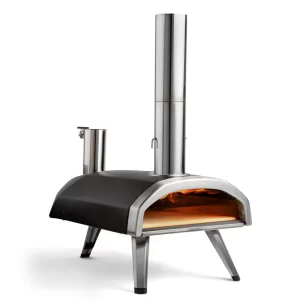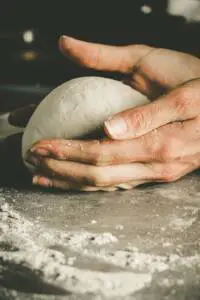The Importance of yeast in pizza dough
- Yeast is a magical ingredient that makes pizza dough rise and gives it a fluffy texture.
- It’s a living organism that converts sugars into gas, alcohol, and acids, creating bubbles in the dough.
- Without yeast, pizza dough would be flat and lifeless, lacking the delicious taste and aroma we love.
Understanding fermentation and its effects on dough
- Fermentation is the process where yeast breaks down the dough’s sugars, developing flavor and texture.
- It’s like a party in the dough, with yeast multiplying and releasing gases that make it rise.
- Longer fermentation allows for more flavor development and a tender, chewy crust.

Factors Affecting Yeast in Pizza Dough
Fermentation time and temperature
- Time and temperature play a crucial role in yeast activity.
- Longer fermentation or warmer temperatures require less yeast, as it multiplies faster in such conditions.
- We can control fermentation by adjusting yeast amounts and letting the dough rest longer.
| Time (Fermentation Period) | Temperature | Yeast Activity |
| 1-2 hours | Room Temp | Active and Rapid Fermentation |
| 2-4 hours | Room Temp | Steady Fermentation |
| 4-8 hours | Room Temp | Slow and Controlled Fermentation |
| 8-12 hours | Room Temp | Extended Fermentation |
| 12-24 hours | Fridge | Slow Cold Fermentation |
| 24-48 hours | Fridge | Very Slow Cold Fermentation |
In this Table, we highlight the relationship between time and temperature for yeast activity during pizza dough fermentation. The table indicates the recommended fermentation periods for different yeast activities at room temperature and in the fridge. Remember to adjust the yeast quantity accordingly to achieve the desired pizza dough texture and flavor.
Baker’s percentages and calculating yeast quantities.
- Baker’s percentages help us compare recipes and determine yeast relative to flour weight.
- For example, 1% yeast in 500g flour would be 5g yeast.
- I use 0.1% yeast, which means for 330g flour, I use 0.33g yeast (approximately 2 pinches).

The impact of yeast on flavor and texture
- Using less yeast results in a dough that doesn’t balloon in size and maintains its strength.
- More yeast might make the dough rise faster, but it sacrifices the flavor and texture development.
- It’s all about finding the right balance and giving the dough ample time to ferment.
Remember, making perfect pizza dough is an art, and finding the ideal yeast quantity takes some practice. Don’t be afraid to experiment with different fermentation times and yeast amounts. The beauty of pizza-making lies in creating a dough that suits your taste and preferences.
Now that we understand the basics of yeast and fermentation in pizza dough, let’s move on to the next section, where we’ll explore why using less yeast is the secret to a delightful pizza crust. Let’s get rolling!
Why Use Less Yeast?
Using less yeast in your pizza dough can lead to fantastic results, creating a tastier and more enjoyable pizza crust. Here’s why you should consider reducing the amount of yeast in your recipe:

The Benefits of Longer Fermentation
- Improved Texture: Longer fermentation allows the dough to break down gradually, resulting in a better texture with a chewy and airy crust.
- Enhanced Flavor: Time is the secret ingredient that develops the dough’s flavor, creating a more complex and delicious taste.
- Better Gluten Structure: Longer fermentation helps the gluten in the dough relax and become more elastic, making it easier to handle and shape.
Avoiding Over-Fermentation and Weak Dough
- Balancing Rise and Strength: Using excessive yeast can cause the dough to rise too quickly, leading to weak and unmanageable dough that lacks structure.
- Prevention of Dough Collapse: A dough with too much yeast might rise dramatically but then deflate when baked, resulting in a disappointing crust.
- Reducing Gassy Taste: Over-fermented dough can develop an overpowering and sour taste due to excessive gas production.
Controlling Alcohol and Acid Development for Better Taste
- Flavorful Complexity: By using less yeast, you can control the production of acids and alcohols, which add depth and complexity to the dough’s flavor.
- Avoiding Alcoholic Smell: Over-fermented dough can produce a strong alcoholic smell, which might not be pleasant.
Recommended Yeast Amounts and Fermentation Times
Here are some simple guidelines to follow when it comes to yeast quantities and fermentation times for your pizza dough:
Guidelines for Different Fermentation Periods
- Quick Rise (Same-Day Dough):
- Recommended Yeast: 3/4 teaspoon of active dry yeast or 1-2/3 teaspoons of instant dry yeast.
- Fermentation Time: About 2-8 hours at room temperature.
- Standard Rise:
- Recommended Yeast: 1/4 teaspoon of active dry yeast or 1 pinch of instant dry yeast.
- Fermentation Time: Minimum 2 hours, but longer fermentation is beneficial (e.g., 24 hours in the fridge).
Using Instant Dry Yeast versus Active Dry Yeast
- Instant Dry Yeast: Use 30%-40% less compared to active dry yeast due to its potency.
- Active Dry Yeast: The recommended quantities mentioned earlier apply for active dry yeast.
Recommended Yeast Quantities for Different Dough Rise Times
- Short Fermentation (Same-Day Dough):
- Recommended Yeast: 3/4 teaspoon of active dry yeast or 1-2/3 teaspoons of instant dry yeast.
- Longer Fermentation (Overnight or Cold Ferment):
- Recommended Yeast: 1/4 teaspoon of active dry yeast or 1 pinch of instant dry yeast.
Remember, these are general guidelines, and you can always adjust the yeast quantity based on your preferences and experimentation. The goal is to find the right balance to achieve a flavorful and perfectly textured pizza crust that suits your taste.
| Fermentation Time | Instant Dry Yeast Percentage | Recommended Yeast Amount for 500g Flour (2-4 dough balls) | Temperature |
| 2 hours | 0.5% | Approximately 2.5g | Room Temperature |
| 5 hours | 0.2% | Approximately 1g | Room Temperature |
| 8 hours | 0.1% | Approximately 0.5g | Room Temperature |
| 18 hours | 0.03% | Approximately 0.15g | Room Temperature |
| 24 hours | 0.3% | Approximately 1.5g | Fridge |
| 48 hours | 0.1% | Approximately 0.5g | Fridge |
| 72 hours | 0.05% | Approximately 0.25g | Fridge |
In this table, we provide yeast percentages and recommended yeast amounts for 500g flour (enough for 3 dough balls) based on different fermentation times and temperatures using instant dry yeast. Feel free to adjust the yeast amount to achieve your desired pizza dough texture and flavor.

Related Topics
- Spices Used in Pizza: Unveiling the Secrets of Irresistible Flavor
- The Best Pizza Dough Hydration
- Best Accessories for Your Ooni Koda 12 Pizza Oven
- Ooni Koda 12 Pizza Oven Review
- Ooni Koda 16 Review: Best Outdoor Cooking Companion!
- How to Use Ooni Fyra Pizza Oven
- Ooni Fyra Lighting: Master the Fire for Perfect Pizzas
- Ooni Fyra 12 Review: Wood-Pellet Perfection – OutingFlame
How to Measure Yeast for Pizza Dough:
Accurate measurement of yeast is essential for getting the perfect pizza dough. Here’s how you can do it with precision:
The Importance of Accurate Measurement:
- Proper measurement ensures the right balance of yeast for optimal fermentation.
- Too much yeast can lead to over-fermentation, while too little can result in under-risen dough.
- Accurate yeast measurement contributes to a consistent and delicious pizza crust.
Using a Kitchen Scale for Precise Measurements:
- Invest in a kitchen scale that measures at least to 0.1g, or better yet, 0.01g intervals.
- Place your mixing bowl on the scale and tare it to zero before adding ingredients.
- Measure the yeast as per the recommended quantity for your recipe, using the scale for accuracy.
Tips for Approximating Yeast Quantities:
- If you don’t have a kitchen scale, you can use common household items for approximation.
- For example, 1g of yeast is roughly equivalent to 1/3 teaspoon or about 2 pinches.
- If you’re using packet yeast (e.g., 7g packets), you can divide it into 7 parts to get 1g of yeast.

Understanding Yeast and Fermentation in Pizza Dough:
To create the best pizza dough, it’s essential to understand how yeast works and how fermentation affects the dough:
The Process of Yeast Activation and Fermentation:
- Yeast is a living organism, and it needs water and sugar to activate and grow.
- When yeast is mixed with water and flour, it consumes the sugars and produces CO2 gas, alcohol, and acids through fermentation.
- The CO2 gas creates bubbles in the dough, causing it to rise, while the alcohol and acids contribute to the dough’s flavor.
The Role of Gluten in Pizza Dough Development:
- Gluten is a protein present in flour that gives the dough its elasticity and structure.
- As the dough is kneaded, gluten forms a stretchy network that traps the CO2 gas produced by yeast, helping the dough rise.
- Over time, the gluten relaxes, altering the dough’s texture to be tender and chewy.
Factors Influencing Yeast Activity and Fermentation:
- Temperature plays a crucial role in yeast activity. Warmer temperatures accelerate fermentation, while colder temperatures slow it down.
- Longer fermentation times allow for more flavor development and better dough texture.
- Other factors like salt and hydration level can also affect yeast activity and the overall dough characteristics.

Understanding yeast and fermentation empowers you to create the perfect pizza dough by controlling the process and achieving the desired taste and texture. Enjoy experimenting with yeast quantities and fermentation times to craft the ideal pizza crust for your pizza-making adventures!
Common Yeast Troubleshooting:
Identifying yeast-related problems in pizza dough:
- Issue: Dough not rising properly.
- Possible Cause: Inactive yeast or incorrect water temperature.
- Solution:
- Check yeast activity by dissolving it in warm water with a pinch of sugar. It should become bubbly and frothy within 10-15 minutes.
- Ensure the water temperature is around 110°F (45°C) for active dry yeast.
- Issue: Excessive rise leading to dough overflow.
- Possible Cause: Too much yeast used.
- Solution: Reduce the amount of yeast in your next batch, as less yeast will ferment slowly and provide a better rise.
- Issue: Dough smells like alcohol or vinegar.
- Possible Cause: Over-fermentation due to excessive yeast or extended fermentation time.
- Solution: Use less yeast or transfer the dough to the fridge sooner to slow down fermentation.
Solutions to common issues like over-fermentation or under-rising:
- Under-rising dough:
- Solution: Increase the yeast quantity slightly, and allow the dough to rise for a longer period, preferably at room temperature.
- Over-fermented dough:
- Solution: Decrease the yeast amount to avoid excessive fermentation. Also, consider a shorter fermentation time.
- Tough crust due to too much yeast:
- Solution: Reduce the yeast and knead the dough gently to prevent overdevelopment of gluten.
- Gummy or undercooked center:
- Solution: Use less yeast, and ensure the oven is preheated properly to bake the pizza at the right temperature.
Pizza Preparation Accessories
Conclusion:
The art of balancing yeast and fermentation for perfect pizza dough:
Achieving the perfect pizza dough lies in finding the right balance between yeast quantity and fermentation time. The slower fermentation allows for the development of rich flavors and a lighter texture.
Encouraging experimentation to find the ideal yeast quantity:
Don’t be afraid to experiment with different yeast quantities and fermentation times to suit your taste preferences. Start with a small amount of yeast and adjust as needed to achieve the desired rise and flavor.
Recap of the benefits of using less yeast in pizza dough:
- Longer fermentation enhances flavor and texture.
- Less yeast prevents excessive rise and weak dough.
- Slower fermentation results in a pleasant taste without overpowering alcohol or sourness.
Remember, making the perfect pizza dough is a journey of trial and error. Embrace the process, have fun, and enjoy the delicious results of your homemade pizza with just the right amount of yeast. Happy baking!
FAQ: Frequently Asked Questions
1. How much yeast should I use in my pizza dough?
- For overnight rise: Use 1/4 teaspoon of active dry yeast per 500 grams of dough (approximately 2 standard-sized pizza dough balls).
- For same-day use: Use about 3/4 teaspoon of active dry yeast or 1-2/3 teaspoons of instant dry yeast per 500 grams of dough.
2. What are baker’s percentages, and how do they help compare recipes?
- Baker’s percentages are percentages of other ingredients’ weight relative to the flour weight in a recipe.
- For example, 1% yeast in a recipe with 500g flour would require 5g of yeast.
3. Why is using less yeast recommended for better pizza dough?
- Less yeast allows for longer fermentation, which improves flavor and texture.
- Dough with excessive yeast rises too quickly, losing strength and becoming harder to shape.
4. How can I calculate the yeast amount based on fermentation time and temperature?
- Refer to the accompanying table for yeast quantities needed at specific temperatures and times.
- Choose a suitable fermentation time and temperature based on your preference and schedule.
5. How can I accurately measure yeast for my pizza dough?
- Use a kitchen scale that measures to at least 0.1g or preferably 0.01g for precise measurements.
- If you don’t have a scale, you can split yeast portions by lining it up on a hard surface using a bank card.
6. What happens during yeast fermentation in pizza dough?
- Yeast converts starches into sugar and produces CO2 gas, alcohol, and other byproducts.
- The gas trapped in the dough causes it to rise, while acids and alcohol add flavor and aroma.
7. How do I troubleshoot common yeast-related issues in pizza dough?
- If dough doesn’t rise at all, the yeast might be dead; test it in water with sugar.
- If dough over-rises and spills out, you used too much yeast; try using half as much next time.
8. Can I freeze pizza dough for later use?
- Yes, you can freeze pizza dough in a freezer-safe container for up to three months.
- Thaw the dough in the fridge the night before you plan to use it.
9. Should I use instant dry yeast or active dry yeast for pizza dough?
- Both types of yeast work, but instant dry yeast requires 30%-40% less than active dry yeast.
- Activate active dry yeast in water before using, while instant dry yeast can be mixed directly.
10. What is the best yeast to flour ratio for a perfect pizza crust?
- Start with a small amount, such as a pinch or two of instant dry yeast per 500 grams of dough.
- Experiment with yeast quantities and fermentation times to find your ideal ratio.














